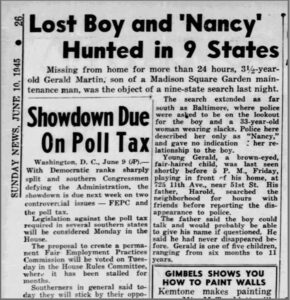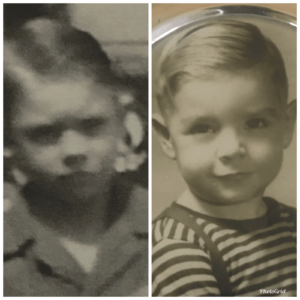By Rachael Rifkin
Identical twins Audrey Bell and Cynthia McFadden, and their younger sister Stephanie, knew that using 23andMe to explore their DNA would give them insight into their ancestry and shared genetics, but they never expected it would also unearth clues to a 75-year-old unsolved mystery.

Twins Audrey and Cynthia, with their sister Stephanie in the middle.
Audrey was the first to dive into her DNA with 23andMe. She wanted to see the DNA differences between her triplets, two are identical and the third is fraternal. But her 23andMe Ancestry Composition report surprised her because she didn’t see any Italian ancestry. It was a shock. The family’s last name is Palmadesso, so their Italian heritage was part of the sisters’ identity. They’d all grown up hearing that her dad’s family was Italian and Irish.
It wasn’t until Cynthia got her 23andMe reports a few months ago, and opted-in to view her DNA relative connections, that the mystery started to deepen for the sisters.

A New York Daily News article about the kidnapping.
Not Italian
Just like her sister, her report didn’t show any Italian ancestry. Instead, it showed she had Irish, Scottish and Spanish ancestry. She also matched with someone she’d never heard of, a 79-year-old man named Tommy Martin. The two share 22 percent of their DNA. That’s the same percentage Cynthia would share with a grandparent or uncle. Cynthia was so surprised by these findings that she asked Audrey to opt-in to view her DNA relative connections to see if she matched with Tommy. She did.
The sisters had no idea who Tommy was or how they were related. 23andMe cautions customers about the possibility of uncovering something unexpected. The sister’s reports certainly fell into that category. At first, they hypothesized that their father, who passed away in 2017, was the child of an unknown affair, and that Tommy was their grandfather. Then they connected with Tommy and his half-sister Mary. As communicated back and forth with Tommy and his sister, a different and much more complicated story began to emerge.

Photos of the brothers as young children with Tommy on the right.
A Kidnapping
Audrey and Cynthia realized that based on his age, Tommy was clearly an uncle, not their grandfather. When they learned why he tested with 23andMe in the first place, the sisters were stunned. Tommy was searching for his younger brother, Gerald “Jerry” Martin, who was kidnapped in 1945.
Tommy and Mary told the twins what happened. He was six, and his brother Jerry was 4 when it happened. The brothers were riding their bikes in Manhattan when a woman approached them. She asked the boys if they wanted some candy. Both said yes. The woman told Tommy to wait while she and Jerry went to buy some. Tommy never saw Jerry again.
Looking for Leads
Audrey, Cynthia and Stephanie wanted to learn more. They found an article on the kidnapping. At first, police suspected Tommy and Jerry’s biological mother was somehow involved. There had been lingering issues with the dissolution of her relationship with Tommy and Jerry’s father, who the children lived with. But the police determined she wasn’t involved. Apart from those early suspicions they had few leads and the trail quickly went cold.
For years, the boy’s father, Harold, checked in with the police department to see if there was anything new about his Jerry. Detectives never found anything solid.
While 23andMe predicted that Cynthia and Audrey were Tommy’s nieces, it was unclear if the twin’s father, who they knew as Richard Rocco Palmadesso, was, in fact, Tommy’s missing brother, Jerry. The sisters suspected that he was, but couldn’t be sure.

The photos of the two brothers with Richard on the left just before he passed away in 2017, and Tommy on the right.
Family History
So they turned their attention to what they knew about their father’s parents, Angelo and Isabel Palmadesso. When their dad was 12, his mom died, so Richard was sent to live with his father’s brother. As an adult, Richard didn’t keep in touch with his father, the uncle who helped raise him or his cousins, and he rarely spoke about them. He did, however, stay in touch with the woman who’d been his nanny, Helen Horgan. Later in life, Helen even lived with Richard, his wife, and the twins. She died when Audrey and Cynthia were 10.
With their father and grandparents now dead, as well as Helen, the sisters had few relatives to turn to for answers. They decided to reach out to his uncle’s son. He told the sisters that the whole family knew their dad was not a blood relative. He believed that it was only their father who didn’t know.
Is Their Dad the Kidnapped Boy?
But there was no story of a kidnapping. Instead, the family rumor was that Helen, the nanny, was his biological mother. According to family lore, he’d been taken in because Helen was a single mother. The twins also learned that the family believed Richard’s mother was a madame, and Helen was one of her prostitutes. The family assumed the father was a local gangster who Helen dated.
Cynthia and Audrey weren’t sure what to believe, but using 23andMe they found that they didn’t share any DNA with their Palmadesso cousins. That left them with two clear facts — they were related to Tommy, but not to the Palmadesso family. But was their dad Tommy’s kidnapped brother?
A Theory
The sisters decided to go back and create a timeline of events. They discovered that Jerry was kidnapped in June of 1945, a couple of months before the man their father Richard thought was his father returned from his service in WWII.
The sisters hypothesized that perhaps Richard’s mother may have lost a baby or felt the need to give her husband a son, and that may have been a motive to kidnap a boy, but they don’t know. They know that Richard’s parents did not have any other children of their own together, although Richard’s mother did have an older daughter from a prior relationship.
Perhaps Richard’s mother thought her husband would be assuaged by having a child to raise, but all that was speculation. The sisters really didn’t know.
And there was also some evidence to suggest their theory isn’t right. For instance, they found a birth certificate for their dad. It listed his birth year as 1943, which would make him two years younger than Jerry Martin. But as the twins point out, it could be a fake birth certificate. After all, their dad’s mom wouldn’t have known how old the kidnapped child was, but the twins simply don’t have evidence to show their theory is true.
A New Family Connection
Meanwhile, Audrey and Cynthia have been getting to know Tommy and his half-sister Mary.
They visited Tommy in Florida around Thanksgiving and learned he loves many of the same things their dad did. They shared a love of movies, acting and coconut cake, and have similar personalities. There’s also a physical resemblance.
“Our dad was always kind, funny, and silly. Always dreamed of being an actor, but never actually acted in anything,” said Cynthia. “Uncle Tom is very similar. He even had some headshots from when he was younger.”
One unexpected outcome of their investigation is that they’ve gained more insight into the kind of person their dad was. From talking to their cousins and other people in his life who knew him when he was younger, they learned that his parents were both hard on him. He would sit at the table and his mother wouldn’t allow him to talk. Their cousin told them that their dad was quiet and anxious all the time, which is basically the way he was as an adult.
“Although our dad was very kind and we were close to him, there was always a disconnect with him and family,” Cynthia said. “It now makes more sense why he may have been this way.”
As for Tommy and his family, the kidnapping took a toll on both his parents and Tommy. He remembered that their father cried a lot, and he never stopped believing that his son Jerry was still out there and alive.
Rachael Rifkin’s work focuses on using storytelling and similarities to bridge the gap between generations, cultures, and backgrounds. Her newsletter, Theory of Relative-ity, is about the similarities that run in families, and what we can learn from those similarities.